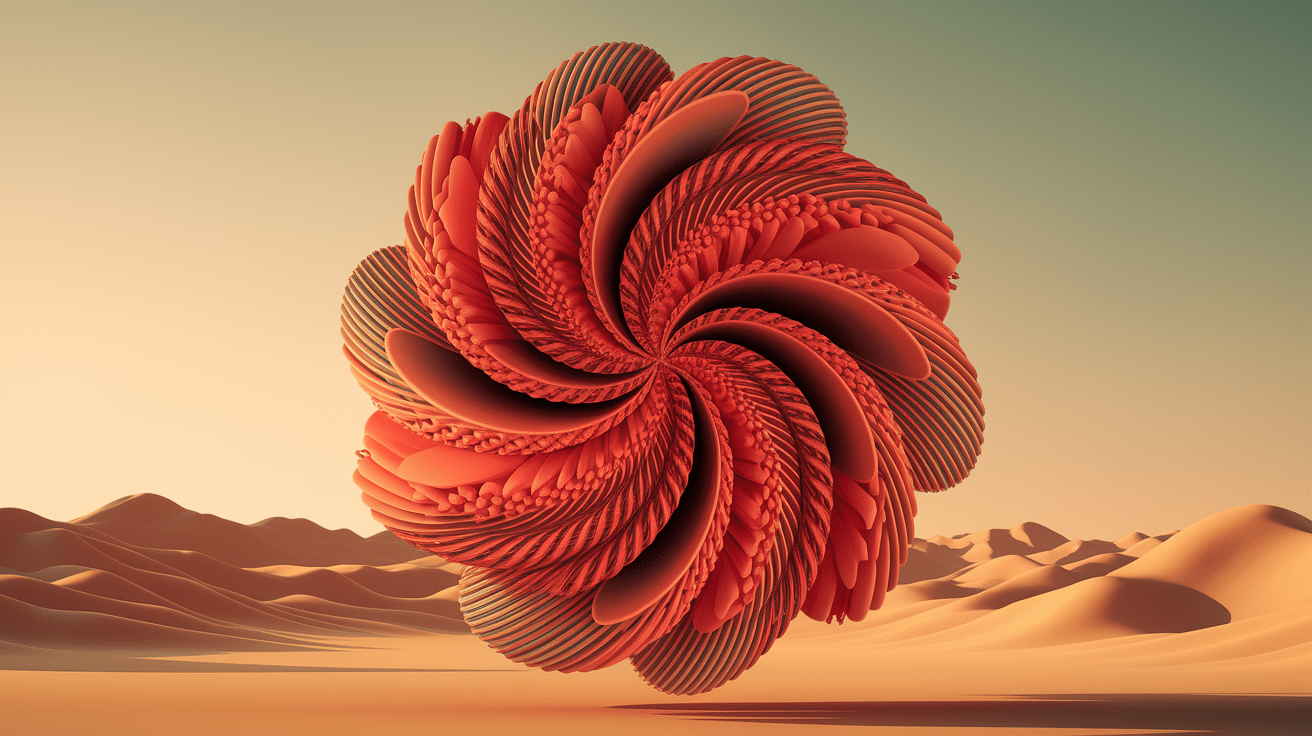What is pattern in art, and why does it captivate us so deeply?
If you’ve admired the swirling circles in Van Gogh’s paintings or the geometric precision of Islamic tile work, you’ve experienced the power of artistic patterns firsthand.
Pattern in art refers to the deliberate repetition of visual elements (shapes, colors, lines, or textures) that create rhythm, unity, and meaning within an artwork.
Far from being mere decoration, patterns serve as fundamental building blocks that help artists guide your eye, evoke emotions, and tell compelling visual stories.
If you’re an art student, a curious viewer, or someone who wants to understand art better, learning about patterns will completely change how you see and appreciate artistic creations.
What are Patterns in Art?
Understanding patterns is fundamental to appreciating how artists create visual harmony and meaning in their work.
These repeated elements form the backbone of artistic composition, guiding viewers through complex visual narratives.
Definition and Basic Concepts
Think of patterns as the heartbeat of artwork. A pattern in art is simply when certain elements, like shapes, colors, lines, or textures, repeat themselves throughout a piece.
It’s like having a visual rhythm that your eyes can follow and understand.
But the thing is that patterns don’t always have to be perfectly identical. Sometimes they repeat the same way, like tiles on a bathroom wall.
Other times, they might change slightly as they repeat, creating what we call variation.
Both types work to create order and structure in art. They help create what artists call visual harmony, which is a way of making everything in the artwork feel like it belongs together.
Fun Fact: The human brain can recognize patterns in as little as 13 milliseconds – that’s faster than the blink of an eye! This is why patterns are so powerful in art.
Why Artists Use Patterns
Artists are quite skilled in how they utilize patterns. They know that our brains love to find order and rhythm in what we see, so they use patterns to create several important effects in their work.
| Purpose | How It Works | Example |
|---|---|---|
| Creating Balance | Elements repeat across a piece to distribute visual weight evenly | Wallpaper uses repeated designs to create calm and order in a room |
| Guiding Your Eyes | Repeated elements create a visual path through the artwork | Like invisible arrows that help you inspect the entire piece |
| Carrying Meaning and Emotion | Different pattern types evoke specific feelings | Chaotic patterns feel energizing; flowing patterns feel peaceful |
Types of Patterns: Two Main Categories
Patterns in art can be organized into two fundamental categories that help us understand their origins and characteristics. These main types form the foundation for all pattern recognition and analysis in artistic works.
Natural Patterns emerge from the world around us, taking inspiration from organic forms, landscapes, and environmental elements. These patterns often feel flowing, irregular, and connected to the rhythms of nature.
- Organic patterns inspired by natural forms
- Environmental patterns addressing ecological themes
- Landscape patterns capturing natural environments
Man-Made Patterns are created by human design and intention, reflecting our desire for order, structure, and symbolic meaning. These patterns showcase human creativity and cultural expression.
- Geometric patterns using mathematical shapes
- Regular/symmetric patterns create balance through repetition
- Irregular/asymmetric patterns achieve dynamic tension through variation
Understanding these two main categories helps you quickly identify and appreciate the different approaches artists use to create visual interest and meaning in their work.
Natural Patterns
Natural patterns take their inspiration directly from the world around us, capturing the organic rhythms and structures found in nature.
These patterns connect us to the fundamental order and beauty that exists in the natural world.
1. Organic Patterns
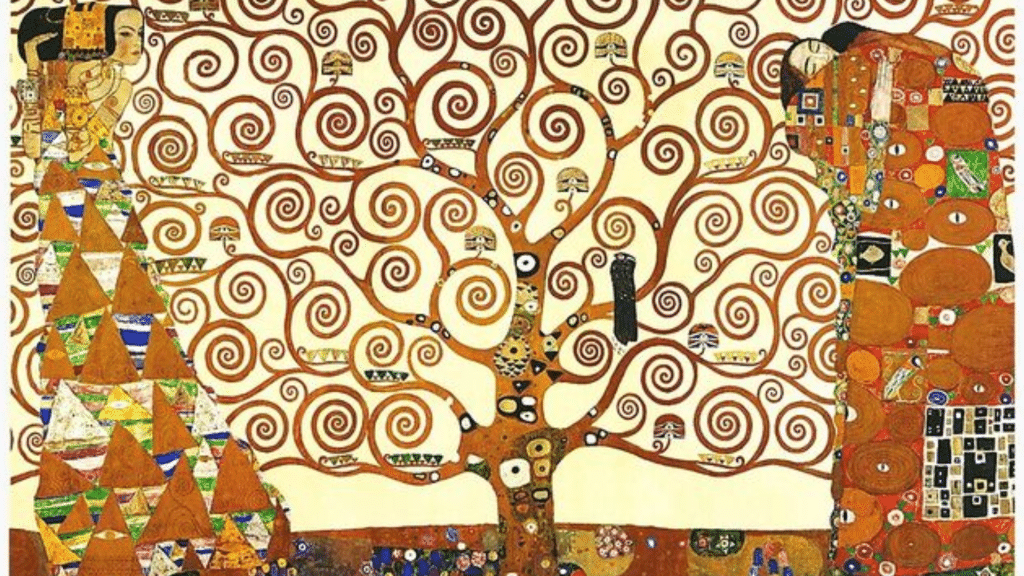
The Tree of Life, Stoclet Frieze- By Gustav Klimt
If geometric patterns are like mathematical equations, organic patterns are like poetry. These patterns flow and curve, often inspired by things we see in nature, like the way water moves, how leaves grow, or how clouds form.
Gustav Klimt’s “The Tree of Life” is a perfect example.
The painting swirls with organic patterns that seem to grow and flow across the canvas, creating a sense of life and movement that feels natural and alive.
2. Environmental Patterns

Aligning Reeds- By Maya Lin
Modern artists increasingly use patterns to make statements about environmental issues and humanity’s relationship with nature, often blending natural forms with human-made elements.
Maya Lin’s “Aligning Reeds” uses repetitive patterns of cast aluminum reeds to highlight environmental loss and fragility.
The installation creates waves of artificial vegetation that mirror natural growth patterns while drawing attention to disappearing wetland ecosystems.
3. Landscape Patterns
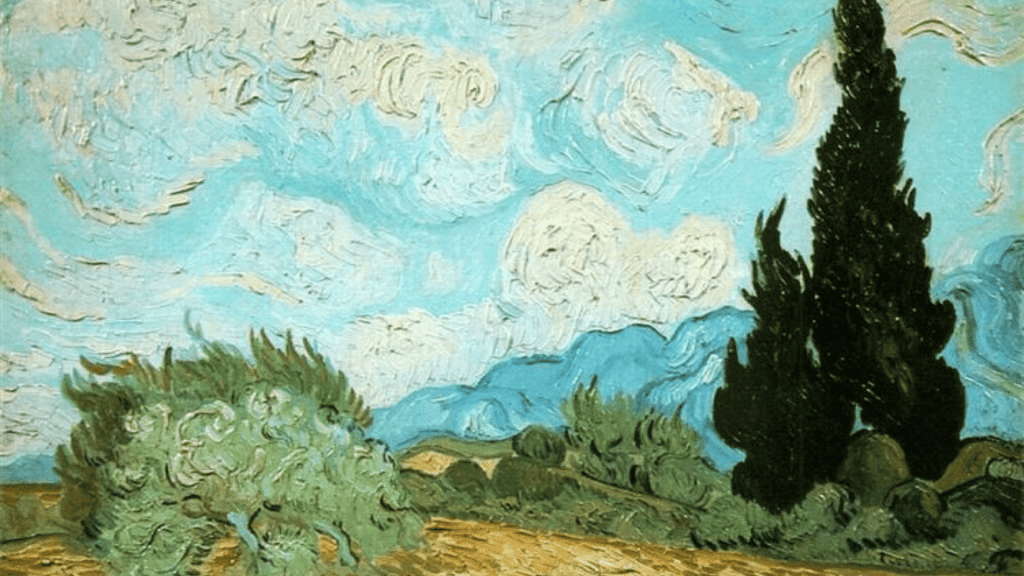
Wheat Field with Cypresses- By Vincent van Gogh
These patterns capture the essence of natural environments, from rolling hills to ocean waves, helping artists convey the vastness and rhythm of natural spaces.
Aboriginal Australian dot paintings exemplify landscape patterns – the repeated dots and lines map actual territories, water sources, and travel routes.
Vincent van Gogh’s swirling patterns in “Wheat Field with Cypresses” make landscapes feel alive and dynamic.
Man-Made Patterns
Human-created patterns reflect our desire for order, structure, and meaning, often serving both functional and aesthetic purposes. These patterns showcase the ingenuity and creativity of human design throughout history.
1. Geometric Patterns
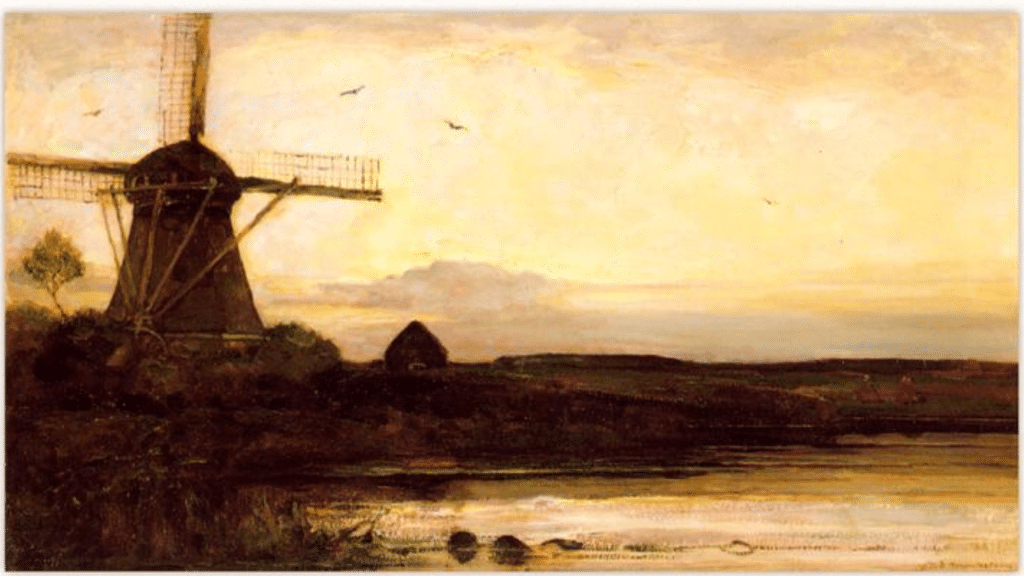
Mill in the evening- By Piet Mondrian
These are the math-lovers of the pattern world! Geometric patterns use regular shapes like squares, triangles, circles, and straight lines.
They create a sense of order and precision that can feel very modern and clean. Piet Mondrian was a master of geometric patterns. His paintings used straight black lines and blocks of primary colors arranged in perfect rectangles.
The result? Artwork that feels balanced and structured, almost like visual music.
2. Symmetrical Patterns
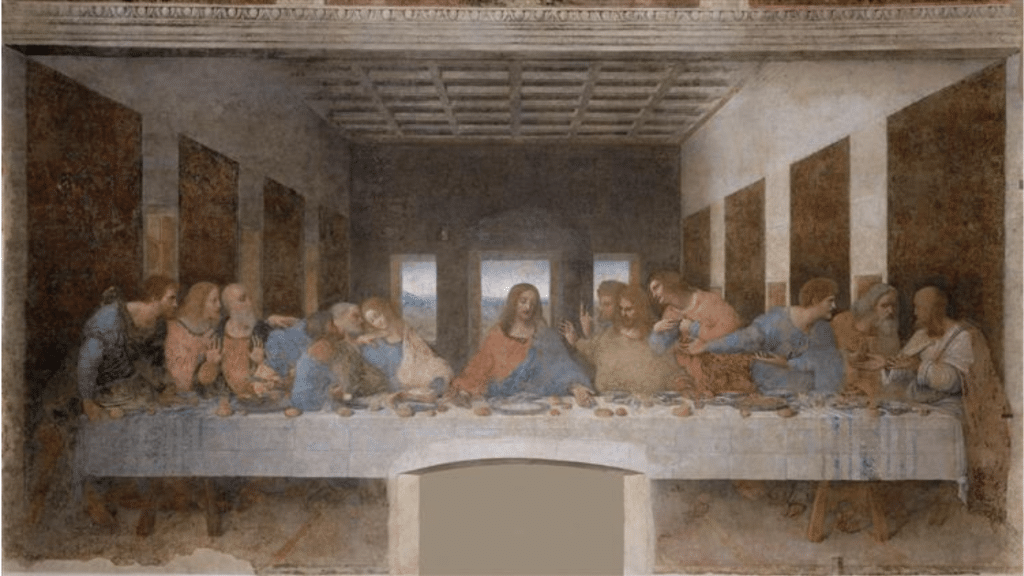
The Last Supper- By Leonardo da Vinci
These patterns are like perfect mirrors; what happens on one side happens the same way on the other side. Symmetrical patterns create a strong sense of balance and can feel very formal and dignified.
Leonardo da Vinci’s “The Last Supper” is a perfect example of symmetrical patterns in action.
The disciples are arranged in four groups of three on each side of Jesus, creating a balanced composition that draws your eye to the center of the painting.
3. Repetitive Patterns
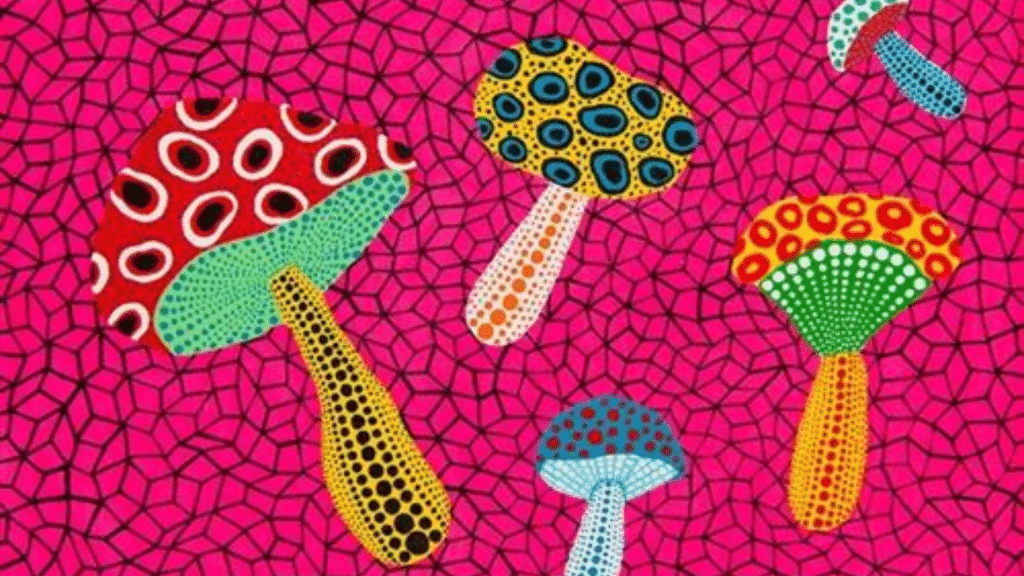
Mushrooms- By Yayoi Kusama
Repetitive patterns create rhythm and unity by systematically repeating the same elements throughout a composition. This repetition establishes consistency and visual order.
Yayoi Kusama’s famous polka dot installations use repetitive patterns to create immersive, almost hypnotic environments.
Her repeated circles cover entire rooms, transforming spaces through the power of systematic repetition.
4. Decorative Patterns
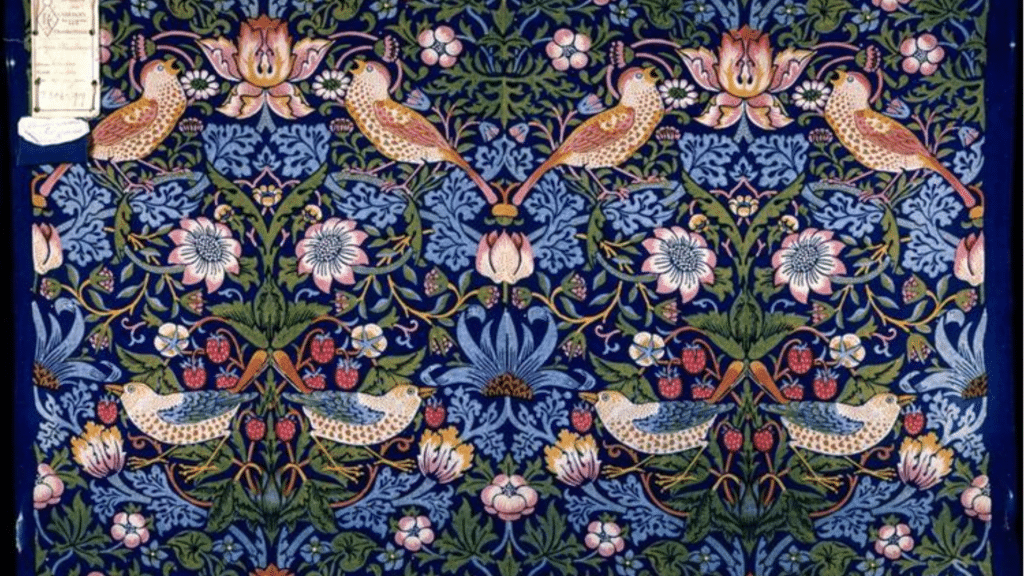
Strawberry Thief- By William Morris
These patterns exist primarily for beauty and visual appeal, adding richness and elegance to artwork. Decorative patterns transform functional objects into works of art, proving that ornamentation itself can be powerful.
William Morris’s “Strawberry Thief” wallpaper design exemplifies decorative patterns – intricate bird and fruit motifs that turn ordinary walls into beautiful environments.
Islamic geometric patterns on mosque walls also serve this decorative purpose while creating spiritual harmony.
5. Asymmetrical Patterns
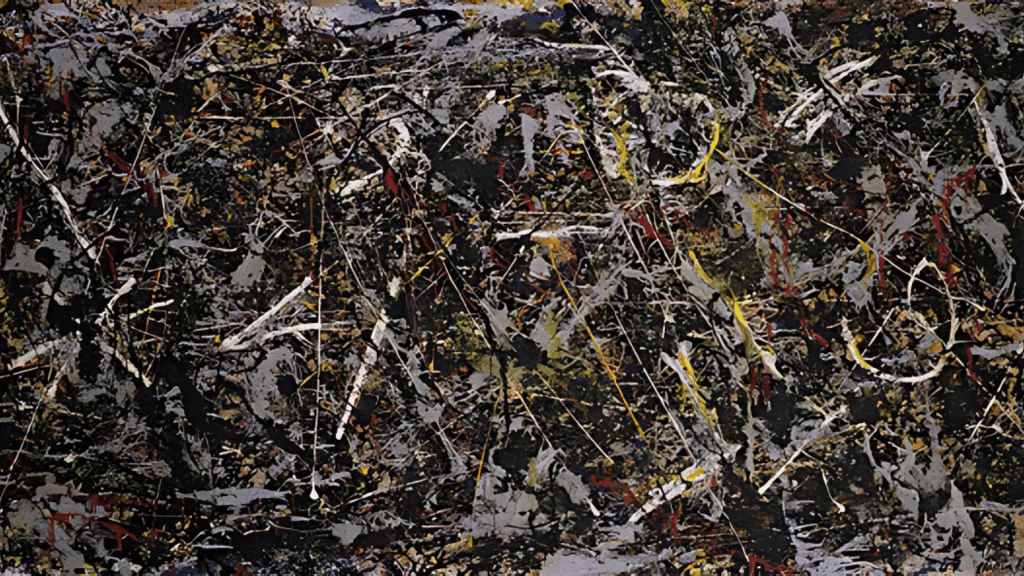
Alchemy- By Jackson Pollock
These patterns don’t let the name fool you – they can be just as balanced as symmetrical ones, but they achieve it differently. Instead of mirroring exactly, they create balance through other means, like using different sizes or colors.
Jackson Pollock’s famous drip paintings are great examples.
At first glance, they might look completely random, but there’s a careful balance of colors and shapes that creates its kind of harmony.
6. Contrasting Patterns
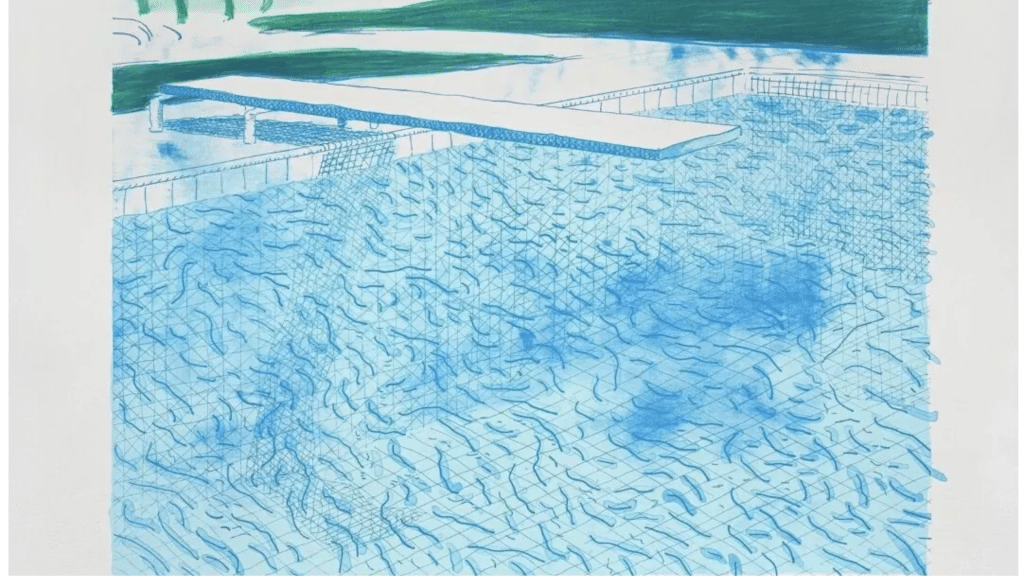
Pool Prints- By David Hockney
Artists use contrasting patterns to create dramatic visual tension by juxtaposing different pattern types or placing patterned areas against solid colors.
David Hockney’s pool paintings contrast geometric tile patterns with organic water ripples, creating compelling visual interest.
African kente cloth also uses contrasting geometric designs within the same piece for a dynamic effect.
How Patterns Function in Art
Patterns do much more than just look pretty. They’re working hard behind the scenes to make art more effective and meaningful.
1. Creating Visual Harmony
When you look at a piece of art, patterns help organize what you’re seeing and create structure for your brain to process.
They work like a visual glue that holds all the different elements of an artwork together, making everything feel like it belongs in the same composition.
2. Guiding the Viewer’s Eye
Artists use patterns strategically to create visual pathways through their work.
A series of repeated shapes or colors can lead your eye from one area of the artwork to another, ensuring you see all the important elements the artist wants to highlight.
3. Evoking Emotions and Mood
Different patterns trigger specific feelings and moods. Regular, predictable patterns tend to feel calming and peaceful, while irregular or chaotic patterns can create tension, excitement, or energy.
Artists choose their patterns carefully based on the emotional response they want to create.
Famous Artists Who Mastered Pattern in Art
Throughout history, certain artists have elevated pattern from mere decoration to high art, using repetition and rhythm as primary vehicles for artistic expression.
Their innovative approaches continue to influence contemporary artists and define how we understand patterns’ role in visual communication.
Case Studies and Examples
1. Piet Mondrian revolutionized geometric patterns with his grid-based compositions using primary colors and black lines, creating perfect visual balance through mathematical precision.
2. Gustav Klimt mastered organic patterns, weaving flowing, nature-inspired designs throughout his paintings that feel both decorative and deeply symbolic.
3. Andy Warhol transformed everyday objects into artistic patterns, using repetition to comment on mass production and consumer culture in modern society.
4. M.C. Escher created mind-bending patterns that seem to repeat infinitely, challenging our perception of space and reality through mathematical precision.
How to Identify Patterns in Art
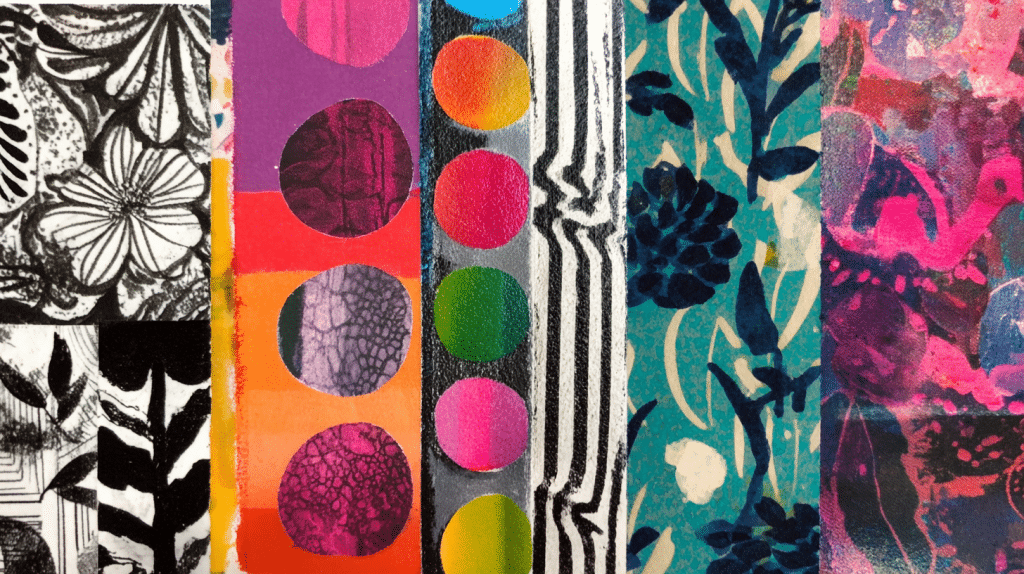
Developing your pattern recognition skills opens up new layers of artistic appreciation and a deeper understanding of artistic intentions.
With practice, you’ll begin to see the subtle ways artists use repetition to create meaning and guide viewer’s experience.
- Look for repeated elements first. Start by identifying what’s being repeated: shapes, colors, lines, or textures.
- Notice the rhythm – Does the pattern feel fast and energetic or slow and peaceful?
- Identify the pattern’s purpose – Is it decorative (adding beauty) or structural (organizing the composition)?
- Observe variations – How does the artist change the pattern while keeping it recognizable?
- Consider the spacing – Are the repeated elements close together or spread apart?
Pattern Analysis in Famous Artworks
Let’s examine how patterns function in specific masterpieces:
Van Gogh’s “Starry Night” uses swirling patterns in the sky that create movement and energy, while the village below uses more geometric patterns for stability and contrast.
Islamic Geometric Art employs mathematical patterns that seem to extend infinitely, creating spiritual symbolism and representing the infinite nature of creation.
Aboriginal Dot Paintings use repeated dots in various colors and sizes to tell stories, map landscapes, and preserve cultural knowledge through visual patterns.
Why Patterns Matter
Understanding patterns in art opens up an entirely new dimension of artistic appreciation.
From geometric precision to organic flow, from ancient cultural symbols to contemporary digital designs, patterns continue to be one of art’s most powerful tools for creating meaning and connection with viewers.
The importance of patterns extends beyond visual appeal:
- Visual Organization – Help your brain make sense of complex artwork
- Emotional Impact – Different patterns trigger specific feelings and moods
- Cultural Communication – Carry meaning across cultures and tell stories
- Viewer Engagement – Guide your eyes through the artwork and maintain interest
Quick Pattern Glossary
Mastering pattern terminology enhances your ability to discuss and analyze artwork with greater precision and confidence. These key terms form the foundation of pattern analysis and artistic critique.
| Term | Definition |
|---|---|
| Visual Rhythm | The sense of movement created by repeated elements |
| Repetition | Exact duplication of elements |
| Variation | Slight changes in repeated elements |
| Motif | A distinctive repeated element or theme |
| Unity | How patterns help all parts of an artwork feel connected |
| Harmony | The pleasing effect when patterns work well together |
Patterns Beyond Art – Everyday Life
Now that you understand what patterns in art are, you’ll start noticing them everywhere you look.
From the repeated arches in classical architecture to the rhythmic brushstrokes in an impressionist painting, patterns are all around us, quietly working to make art more beautiful and meaningful.
The next time you visit a museum, walk through your city, or even scroll through social media, take a moment to look for patterns.
You’ll find that understanding patterns opens up a whole new way of appreciating the artistic world around you.
Start your pattern-spotting adventure today and share your findings in the comments below – tell us which patterns you’ve spotted in your favorite artworks!

